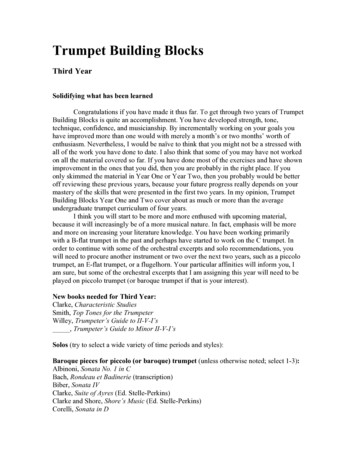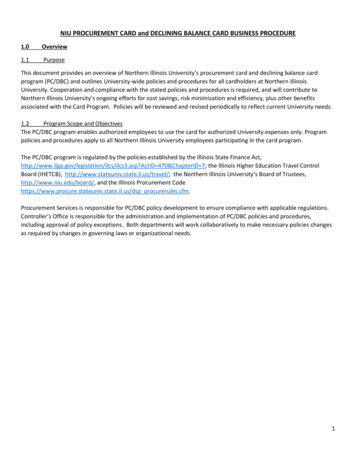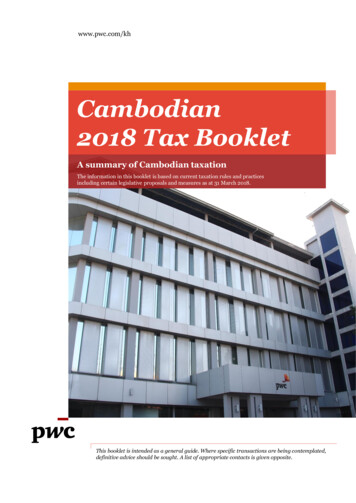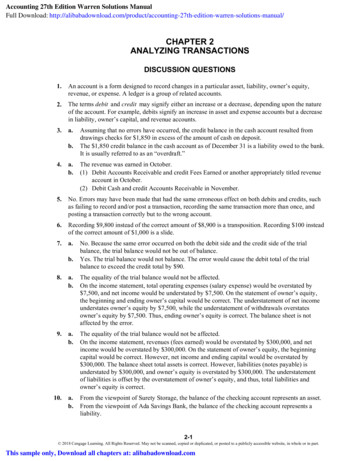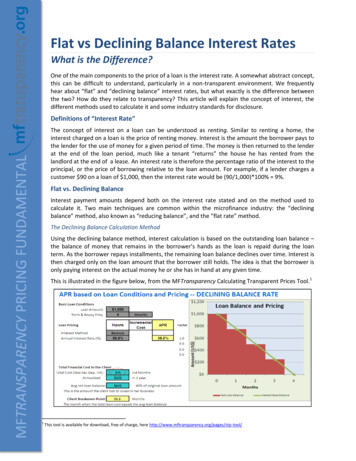
Transcription
Flat vs Declining Balance Interest RatesWhat is the Difference?One of the main components to the price of a loan is the interest rate. A somewhat abstract concept,this can be difficult to understand, particularly in a non-transparent environment. We frequentlyhear about “flat” and “declining balance” interest rates, but what exactly is the difference betweenthe two? How do they relate to transparency? This article will explain the concept of interest, thedifferent methods used to calculate it and some industry standards for disclosure.MFTRANSPARENCY PRICING FUNDAMENTALDefinitions of “Interest Rate”The concept of interest on a loan can be understood as renting. Similar to renting a home, theinterest charged on a loan is the price of renting money. Interest is the amount the borrower pays tothe lender for the use of money for a given period of time. The money is then returned to the lenderat the end of the loan period, much like a tenant “returns” the house he has rented from thelandlord at the end of a lease. An interest rate is therefore the percentage ratio of the interest to theprincipal, or the price of borrowing relative to the loan amount. For example, if a lender charges acustomer 90 on a loan of 1,000, then the interest rate would be (90/1,000)*100% 9%.Flat vs. Declining BalanceInterest payment amounts depend both on the interest rate stated and on the method used tocalculate it. Two main techniques are common within the microfinance industry: the “decliningbalance” method, also known as “reducing balance”, and the “flat rate” method.The Declining Balance Calculation MethodUsing the declining balance method, interest calculation is based on the outstanding loan balance –the balance of money that remains in the borrower’s hands as the loan is repaid during the loanterm. As the borrower repays installments, the remaining loan balance declines over time. Interest isthen charged only on the loan amount that the borrower still holds. The idea is that the borrower isonly paying interest on the actual money he or she has in hand at any given time.This is illustrated in the figure below, from the MFTransparency Calculating Transparent Prices Tool.11This tool is available for download, free of charge, here http://www.mftransparency.org/pages/ctp-tool/
Suppose you lend 1,000, to be repaid in 4 equal monthly payments. The stated interest rate is 36% peryear, or 3% per month, calculated on declining balance. Each period, before applying the interest rate,the outstanding balance is recalculated. On the graph at right, the red area represents the loan balanceand the green line represents the interest rate balance. As you can see from the red-steps on the graph,in early months, the outstanding balance is high. Accordingly, the interest payment is relatively high, 3%of 1,000 or 30. As the principal balance declines over time, the interest rate balance follows. In thelast period the interest amount paid is only 7.50. In this case, as the borrower retains less of theoriginal loan amount, their interest payments decrease. They are only paying “rent” on the loan amountthey still have. In our example, total interest payments made by the borrower are 75 in 4 months.The Flat Calculation MethodWhen using the flat rate method, interest is charged on the full original loan amount throughout theloan term, rather than on the money that the borrower actually has in her hands. This scenario isdepicted in the figure below.Consider a similar example of a 1,000 loan with an interest rate of 3% per month, but charged usingthe flat method, for 4 months. Like the first example, the interest paid in the first month is 30. Butunlike the first, this payment remains 30 throughout the loan term. As you can see by looking at thegreen line relative to the red area on the graph, the interest rate is charged on the initial loan balancethe entire term, although the borrower is holding less and less money. The area of the rectangle underthe green line is almost double the area under the red-step loan balance. The overall interest paid in 4months is then 1,000 multiplied by 3% and then by 4 months, a total of 120.Recall, when using the same interest rate of 3% per month on a 1,000 loan, with the declining balancemethod the total interest rate was only 75. Although both loans state an interest rate of 3% permonth, the one using the flat interest rate calculation method results in almost twice as much ininterest payments for the client.Why is the Flat Calculation Method So Commonly Used in the Microfinance Industry?The flat rate calculation method is widely used by micro lenders. As illustrated in the figure below,according to the MFTransparency database2, interest for more than 3 in every 10 micro loan products iscalculated using flat rate method. This is particularly prevalent in Africa, where about 70% of loan2Countries are Azerbaijan, Bolivia, Bosnia and Herzegovina, Burkina Faso, Cambodia, Colombia, Ecuador, India, Kenya, Malawi, Senegal, UgandaMFTransparency2
products include interest calculated using the flat rate method as compared to Latin America where theratio is just 5%. Interestingly, this is largely due to the fact that the Latin American markets representedin the database all operate under legislation that promotes the use of the declining balance method. Thefollowing table illustrates the use of flat interest rates by country, according to the ia andHerzegovinaBurkina enegalUgandaTOTAL% ProductsUsing FlatInterest Rates14%9%22%86%8%3%2%57%81%79%50%68%77%35%The flat rate calculation method has become prevalent in markets where there is a lack of transparencyand the mechanisms to facilitate it. The flat rate allows financial institutions to advertise costs that arenearly twice as high as they appear. To most borrowers, especially those with minimal financialeducation, the flat rate seems cheaper.Flat rate vs. Declining Balance by uropeLACDeclining BalanceThe flat rate calculation method is oftenpreferred by microfinance institutions forseveral reasons. As explained above, using theflat rate calculation method is an easy way forinstitutions to increase their income withoutgiving clients the impression that their pricesare more expensive. Because the interestpayment is the same amount each repaymentperiod, some institutions also argue that usingthe flat method is easier for their staff andclients to understand. In reality, it is possible forinstitutions, even without a sophisticated MIS,to calculate the declining balance interest rateand communicate payment amounts to clientseffectively.
Once one institution begins to calculate their prices this way it is difficult for others to compete using adeclining balance rate that appears higher but may actually be less expensive. For example, a lenderusing declining balance calculation must set the interest rate as high as 56.3% per year to collect thesame amount of total interest payment as another one who is using a 36% per year flat rate. Withoutpolicy or standards in place to prevent this, institutions must resort to non-transparent practices inorder to be competitive.Why Should Institutions Use the Declining Balance Rate?Widespread adoption of the declining balance interest rate calculation method is better formicrofinance borrowers, and the market as a whole, for several reasons: It is an accurate reflection of the cost of borrowing. There is no theoretical basis for the flatmethod. It does not make sense for a borrower to pay interest on money they do not have.It is closer to the actual price. A transparently communicated price is one that most closelymatches the overall cost of borrowing when all charges are considered. Compared to thedeclining balance, the flat calculation method is far from this. Prices calculated using flat interestpayments sound much lower than those using declining balance interest rates. However, thedeclining balance calculation method is more transparent because the figure communicated tothe client is closer to the figure representing the actual percentage of the loan amount paid ininterest.Using one method, borrowers can compare prices. It is very difficult for borrowers to comparea loan with a 15% flat interest rate to a 25% declining balance rate. If all institutions used thesame calculation method then borrowers would be able to make more informed decisions.It enables price competition based on transparency. When borrowers are able to compareprices then institutions can compete more effectively, potentially resulting in better services andultimately lower rates. Institutions can also make smarter price-setting decisions.For institutions that are concerned that borrowers may find it difficult to pay a different amount ininterest each repayment period, amortizing principle payments is an effective way to use a decliningbalance interest rate and still require equal repayment amounts each period. Through amortization, theprinciple payment each period increases over the loan term while the interest payment decreases (ordeclines), so that the total installment amount the borrower must pay is the same each period.For example, consider a loan of 1,000 with a declining balance interest rate of 24% annually and a loanterm of 6 months. If an institution required equal principle payments each month, the repaymentschedule would be as follows:Repayment Schedule – Equal Principle PaymentsPeriod # Balance Principal PaidInterest 6760.00166.673.33TOTALS: 1,000.0070.00MFTransparency4Installment Amount186.67183.33180.00176.67173.33170.001,070.00
Notice the installment amount is different each month. Alternatively, the institution could use theamortization method. In this case, the repayment schedule would be as follows:Repayment Schedule – Equal Installment AmountsPeriod # Balance Principal PaidInterest 9360.00175.033.50TOTALS: 1,000.0071.15Installment Notice that the installment amount is the same each month, much easier for the borrower to rememberand the loan officer to track. The amount of interest paid is slightly more on the amortized loan but theAPRs are the same, 24%, because through amortization the borrower repays the loan amount moreslowly, and therefore has more time to use the principle amount to generate income.There are several ways of encouraging the use of the declining balance method. Regulators andpolicymakers can implement official policy requiring it. Reporting standards such as the TransparentPricing Initiative can help create a conducive environment for transparency. Through coordinatedindustry-wide effort, microfinance markets can take important steps toward establishing transparentpricing practices.MFTransparency is promoting price transparency by educating stakeholders, promoting standards fordisclosure and by publishing the true costs of microfinance products in a clear, consistent fashion. Tolearn more please visit www.mftransparency.org or contact us at resources@mftransparency.orgMFTransparency5
different methods used to calculate it and some industry standards for disclosure. Definitions of "Interest Rate" The concept of interest on a loan can be understood as renting. Similar to renting a home, the interest charged on a loan is the price of renting money. Interest is the amount the borrower pays to
